1st FebruaryBorn: Tiberius Hemsterhuys,1685, Groningen; Edward Coke, Lord Chief Justice, 1551-2, Mileham; John Philip Kemble, actor, 1757, Prescot. Died: Pope Alexander VIII, 1691; Charles Duke of Shrewsbury, 1717; Sir Hew Dalrymple, President of the Court of Session, 1737; William Aiton, botanist, 1793, Kew; Dr. John Lempriere (Classical Dictionary), 1793; Edward Donovan, naturalist, 1837; Mary Woolstoncraft Shelley (ne'e Godwin), novelist, 1851. Feast Day: St. Ignatius, bishop of Antioch, martyr, 107. St. Rionius, priest and martyr, 250. St. Kinnia, virgin of Ireland, 5th century. St. Bridget (or Bride), patroness of Ireland, 523. St. Sigebert II, King of Austrasia, 656. ST. IGNATIUSIgnatius occupies an important place in the history of Christianity, as an immediate disciple and successor of the apostles. As bishop of Antioch, in which position he acted for forty years, he is admitted to have been a perfect model of virtue and pious zeal. Under the Emperor Trajan, this holy man was sent to Rome to be devoured by wild beasts -a martyrdom to which he submitted with the usual resignation and joy. What was left of the feeble old man was carefully brought back to Antioch, and preserved for the veneration of the faithful. There are, however, more important relics of the martyr in four epistles, a translation of which was published by Archbishop Wake, in 1693. ST. BRIDGET, OR St. BRIDESt. Bridget was a native of Ireland, and has the honour to share with St. Patrick the distinction of exercising the spiritual patronage of that island. She was a daughter of one of the princes of Ulster, and was born at Fochard, in that province, soon after the first conversion of Ireland to the Christian faith. As she grew up she became remarkable for her piety, and having taken the monastic vow, she was the first nun in Ireland, and has ever since been reverenced by the Irish Romanists as the mother of nunneries in that country. She built her first cell under a large oak, which had perhaps been the site of pagan worship in earlier times, and from whence it was named Kildara, or the cell of the oak. Round this first Irish nunnery eventually arose the city of Kildare. The date at which St. Bridget founded her cell is said to have been about the year 585. After having astonished the Catholic world by a number of extraordinary miracles, which are duly chronicled in her legends, she died, and was buried at Downpatrick, the church of which boasted also of possessing the bodies of the saints Patrick and Columba. Giraldus Cambrensis has recorded how, in 1185, soon after the conquest of Ulster by John de Courci, the bodies of the three saints were found, lying side by side, in a triple vault, St. Patrick occupying the place in the middle, and how they were all three translated into the cathedral. This event appears to have created a great sensation at the time, and was commemorated in the following Latin distieh, which is frequently quoted in the old monastic chronicles: In burp Duno tumulo tumulantur in Imo Brigicla, Patricius, atque Columba pins. For some cause or other Bridget was a popular saint in England and Scotland, where she was better known by the corrupted or abbreviated name of St. Bride, and under this name a number of churches were dedicated to her. We need only mention St. Bride's Church in Fleet-street, London. Adjoining to St. Bride's Churchyard, Fleet-street, is an ancient well dedicated to the saint, and commonly called Bride's Well. A palace erected near by took the name of Bridewell. This being given by Edward VI to the city of London as a workhouse for the poor and a house of correction, the name became associated in the popular mind with houses having the same purpose in view. Hence it has arisen that the pure and innocent Bridget-the first of Irish nuns-is now inextricably connected in our ordinary national parlance with a class of beings of the most opposite description. THE DUKE OF SHREWSBURYThe fortunes of this distinguished nobleman present a remarkable instance of the attainment of the highest honours of rank and state, but limited to his own individual enjoyment of such distinctions. He was the elder son of the eleventh Earl of Shrewsbury, who died of a wound received in his duel with George Villiers, second Duke of Buckingham, at Barnes. He was born in the year of the Restoration, and had Charles the Second for his god-father. In 1691, he was created Marquis of Alton and Duke of Shrewsbury, and installed a Knight of the Garter. His grace was a prominent statesman in the reigns of William and Mary, Queen Anne, and George I, and filled some of the highest official situations. He had quitted the Church of Rome and become a Protestant in 1679, and by his steady adherence to the Protestant cause had incurred the displeasure of James II. He was one of the seven who, in June 1688, joined the celebrated association, inviting over the Prince of Orange. At the demise of Queen Anne (who delivered to him the Treasurer's staff on her death-bed), the Duke of Shrewsbury was, at the same time, Lord Lieutenant of Ireland, Lord High Treasurer of Great Britain, and Lord Chamberlain,-a circumstance, says Sir Bernard Burke, (Peerage and Barotnet-age, edit. 1862,) previously unparalleled in our history. His grace, on that occasion, secured the Hanoverian accession, by at once signing the order for proclaiming George I. The Duke married the daughter of the Marquis of Palliotti, but died without issue, when the dukedom and marquisate expired, and the earldom, &c., reverted to his cousin. THE TWO PRINCES OF ANAMABOEIn the London season of 1749, two black princes of Anamaboe were in fashion at all the assemblies. Their story is very much like that of Oroonoko, and is briefly this: A Moorish king, who had entertained, with great hospitality, a British captain trafficking on the coast of Africa, reposed such confidence in him as to intrust him with his son, about eighteen years of age, and another sprightly youth, to be brought to England and educated in the European manners. The captain received them, and basely sold them for slaves. He shortly after died; the ship coming to England, the officers related the whole affair; upon which the Government sent to pay their ransom, and they were brought to England, and put under the care of the Earl of Halifax, then at the head of the Board of Trade, who had them clothed and educated. They were afterwards received in the higher circles, and introduced to the King (George II) on the 1st of February. In this year they appeared at Covent Garden Theatre, to see the tragedy of Oroonoko, where they were received with a loud clap of applause, which they returned with 'a genteel bow.' The tender interview between Imoinda and Oroonoko so affected the Prince, that he was obliged to retire at the end of the fourth act. His companion remained, but wept all the time so bitterly, that it affected the audience more than the play. WILLIAM AITON AND THE 'HORTUS KEWENSISIn the neatly kept churchyard of Kew, in Surrey, rest the remains of William Aiton, 'late gardener to his Majesty at Kew,' a reputation which he largely extended by the publication of the famed Catalogue of Plants in the royal gardens, entitled the Hortus Kewensis. He had been superintendent of the gardens from their first establishment; and in honour of his professional abilities and private worth, at his funeral the pall was supported by Sir Joseph Banks, the Rev D. Goodenough, Dr. Pitcairne, Mr. Dundas (of Richmond), and 'Zoffany, the painter. THE BELL ROCK LIGHTHOUSE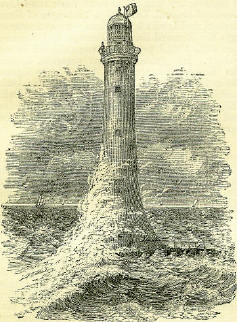
For more than half a century has this noble structure braved the storms of the German Ocean without any of its masonry being displaced. It was first lighted on the 1st of February 1811. The Inch Cape Rock, Scape Rock, as it is termed in the oldest charts, or Bell Rock, lies on the coast about twenty-four miles east of Dundee harbour, in the track of all vessels making for the estuaries of the Friths of Forth and Tay, from a foreign voyage. It was, from a very remote period, the scene of numerous shipwrecks. The top of the rock being visible at low water, one of the abbots of Aberbrothock attached to it a framework and a bell, which, being rung by the waves, warned mariners to avoid the fatal reef. A tradition respecting this bell has been embodied by Dr. Southey in his ballad of 'Ralph the Rover.' A notorious pirate of this name is said to have cut the bell from the framework, to plague the Abbot of Aberbrothock,' and some time after he is said to have received the just punishment of his wickedness, by being ship-wrecked on the spot. The necessity of erecting a lighthouse upon this rock was painfully shewn in the year 1799, when about seventy vessels were wrecked on the coast of Scotland in a terrific storm. This calamity drew the attention of the Commissioners of the Northern Lighthouses to the Inch Seape, and Mr. Robert Stevenson, the scientific engineer of the Lighthouse Board, erected the present edifice from his own designs, between the years 1807 and 1811. The rock being bare only during short daily intervals, the work necessarily became very troublesome, as well as in some degree critical. All the stones were shaped and prepared at Arbroath; and the several courses having been dove-tailed, and cemented together by joggles of stone and oaken trenails, the whole building, when erected upon the rock and properly fixed and cramped, was constituted into one solid mass, which seems likely to defy the elements for centuries. The light-room is of cast-iron, and the entire height of the pillar is 115 feet. The cost was £60,000. In the arrangements, the primitive contrivance of the bell has not been forgotten: during stormy and foggy weather, the machinery which causes the reflectors to revolve, is made to ring two large bells, each weighing about 12 cwt., in order to warn the seaman of his danger when too nearly approaching the rock. When Sir Walter Scott visited this lighthouse in 1815, he wrote in the album kept there the following lines: PHIAROS LOQUITUR Far on the bosom of the deep, 0'er these wild shelves my watch I keep; A ruddy gem of changeful light, Bound on the dusky brow of Night; The seaman bids my lustre hail, And scorns to strike his tim'rous sail A work precisely similar to the erection of the Bell Rock Lighthouse-the formation of a light-house on the rock called Skerryvore, in the Hebrides-was executed between 1835 and 1844, by Alan Stevenson, son of Robert, under circumstances of even greater difficulty and peril: such are among the works which give great engineers a kind of parallel place in our pacific age to that of the mythic heroes of a primitive one. Of each work, an elaborate detail has been published by their respective chiefs. A curious circumstance connected with the building of the Inch Scape Lighthouse is mentioned in a late work: 'One horse, the property of James Craw, a labourer in Arbroath, is believed to have drawn the entire materials of the building. This animal latterly became a pensioner of the Lighthouse Commissioners, and was sent by them to graze on the island of Inchkeith, where it died of old age in 1813. Dr. John Barclay, the celebrated anatomist, had its bones collected and arranged in his museum, which he be queathed at his death to the Royal College of Surgeons [Edinburgh], and in their museum the skeleton of the Bell Rock horse may yet be seen.' THE WAY SHREWS WERE TAMED LONG AGO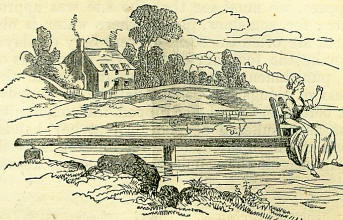
'Madam,' said Dr. Johnson, in a conversation with Mrs. Knowles, 'we have different modes of restraining evil: stocks for the men, a ducking-stool for women, and a pound for beasts.' On other occasions, the great lexicographer speaks very complacently of the famous remedy for curing shrews, so much approved by our fore-fathers, but, fortunately, already a little out of fashion in the worthy Doctor's time. One of the last instances on record in which the ducking-stool is mentioned as an instrument of justice, is in the London Evening Post of April 27th, 1745. 'Last week,' says the journal, 'a woman that keeps the Queen's Head ale-house at Kingston, in Surrey, was ordered by the court to be ducked for scolding, and was accordingly placed in the chair, and ducked in the river Thames, under Kingston bridge, in the presence of 2,000 or 3,000 people.' According to verbal tradition, the punishment of the ducking-stool was inflicted at Kingston and other places up to the beginning of the present century. However, the 'stool' was but rarely used at this period; though it was very extensively employed in the sixteenth and seventeenth centuries. M. Misson, an intelligent Frenchman, who travelled in England about the year 1700, gives the following interesting description of the ducking-stool. 'This method,' he says, 'of punishing scolding women is funny enough. They fasten an arm-chair to the end of two strong beams, twelve or fifteen feet long, and parallel to each other. The chair hangs upon a sort of axle, on which it plays freely, so as always to remain in the horizontal position. The scold being well fastened in her chair, the two beams are then placed, as near to the centre as possible, across a post on the water-side; and being lifted up behind, the chair, of course, drops into the cold element. The ducking is repeated according to the degree of shrewishness possessed by the patient, and generally has the effect of cooling her immoderate heat, at least for a time.' An illustration exactly answering to this description is given as the frontispiece of an old chap-book, entitled Strange and Wonderfel Relation of the Old Woman who was drowned at Ratcliff Higlhway, a fortnight ago. Apparently, in the case of this aged person, the administrators of the punishment had given a dip too much; and, of course, in such rough proceedings, a safe measure must have been difficult to hit. 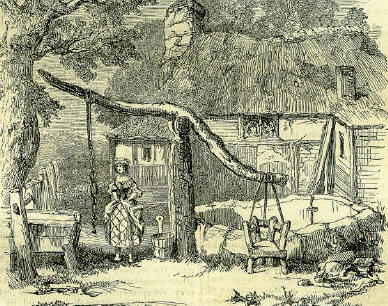 A second illustration, which has been furnished by a gentleman well acquainted with English village life, represents the apparatus as erected close to a watering trough, into which the patient, of course, was let down by the cross-tree, from which the seat depended. Presuming this to be the place whither the females of the village resorted for supplies of water for domestic purposes, we must see that the site was appropriate; for, somehow, places where water is obtained, are often the scene of very fiery displays. To make the fountain of the evil the means of the punishment was in accordance with the fitness of things. It is but natural to suppose that before any scold was dipped, the community must have suffered a good deal at her hands. When at length the hour of retribution arrived, we can imagine the people to have been in a state of no small excitement. Labour would be deserted. All the world would be out of doors. The administrators would appear in young eyes to have something of a heroic bearing. Men 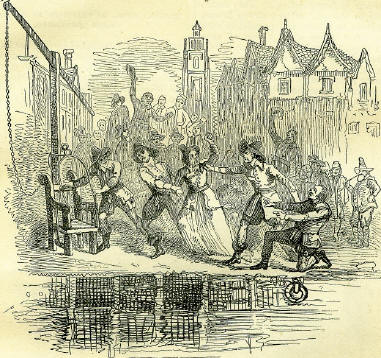 would shout; women would look timidly from doors; dogs would yelp. The recalcitrations of the peccant dame, her crescendo screamings and invectives, the final smotherment of her cries in the cold but not cooling element, must have furnished a scene for a Hogarth or a Wilkie. Failing such illustrations, the reader will accept one from Clarke's History of Ipswich, in which a good deal of what is characteristic of such scenes is displayed. It is impossible to view the picture with perfect gravity; and yet modern humanity, it must be admitted, cannot quite sanction the idea of employing such means of correction for one of the weaker, if not always the gentler sex. Mr. Cole, the antiquary, writing about 1780, says: 'In my time, when I was a boy and lived with my grandfather in the great corner house at the bridge-foot, next to Magdalen College, Cambridge, and rebuilt since by my uncle, Joseph Cock, I remember to have seen a woman ducked for scolding. The chair hung by a pulley fastened to a beam about the middle of the bridge; and the woman having been fastened in the chair, she was let under water three times successively, and then taken out. The bridge was then of timber, before the present stone bridge of one arch was built. The ducking-stool was constantly hanging in its place, and on the back panel of it was an engraving representing devils laying hold of scolds. Some time after, a new chair was erected in the place of the old one, having the same device carved on it, and well painted and ornamented.' That the cold water cure had a wholesome effect upon the tongues of not a few of the fair sex is agreed on by all old writers who mention the subject, poets as well: I'll speed me to the pond, where the high stool On the long plank hangs o'er the muddy pool: That stool, the dread of every scolding queen. The term Cucking-stool is sometimes used inter-changeably for ducking-stool, the resemblance of the names having apparently led to an idea that they meant the same thing. In reality, the cucking-stool was a seat of a kind which delicacy forbids us particularly to describe, used for the exposure of flagitious females at their own doors or in some other public place, as a means of putting upon them the last degree of ignominy. In Scotland, an ale-wife who exhibited bad drink to the public was put upon the Cock stale, and the ale, like such relics of John Girder's feast as were totally uneatable (see Bride of Lammermoor), was given to 'the pure folk.' In Leicester, in 1457, a scold was put upon the cuck-stool before her own door, and then carried to the four gates of the town. The practice seems a strange example of the taste of our ancestors; yet in connection with the fact, it is worthy of being kept in mind, that among the ceremonies formerly attending the installation of the Pope, was the public placing of him in a similar chair, called the Sedes Stercoraria, with a view to remind him that he was after all but a mortal man. This rather expensive cucking-stool must have been in very frequent use in the good town of Kingston; for in the old account books there are numerous entries of money paid for its repairs. In fact, Kingston seems to have enjoyed quite a preeminence in the matter of shrews, to judge by the amount of money laid out in their taming. Shrewsbury itself lags far behind in the cold-water cure; for, as stated in the History of Shropshire, it was only in the year 1669 that an order was issued by the corporation of the town, that 'a ducking-stool be erected for the punishment of scolds.' The ducking-stool, the oldest known remedy for evil tongues-so old, indeed, that it is mentioned in the Doomsday Survey, in the account of the city of Chester-was superseded to a certain extent, in the seventeenth century and later, by another piece of machinery, called the Bran ice. The branks was homoeopathic rather than hydropathic; and connoisseurs were enthusiastic in asserting that it possessed great advantages over the ducking-stool. Old Dr. Plot, in his History of Staffordshire, informs his readers that: 'they have an artifice at Newcastle-under-Lyne and Walsall, for correcting of scolds, which it does so effectually, that I look upon it as much to be preferred to the dunking-stool, which not only endangers the health of the party, but also gives the tongue liberty 'twist every dip, to neither of which this is at all liable: it being such a bridle for the tongue as not only quite deprives them of speech, but brings shame for the transgression and humility thereupon, before 'tis taken off: which being put upon the offender by order of the magistrate, and fastened with a padlock behind, she is led round the town by an officer, to her shame, nor is it taken off till after the party begins to shew all external signes imaginable of humiliation and amendment.' The warm - hearted Doctor gives a representation of a pair of branks, as seen in various cities of Staffordshire about the year 1680. The instruments look formidable enough, consisting of hoops of metal passed round the neck and head, opening by means of hinges at the sides, and closed by a staple with a padlock at the back; a plate within the hoop projecting inwards pressed upon the tongue, and formed an effectual gag. We must take it upon the assurance of so learned a man as Dr. Plot, who was keeper of the Ashmolean Museum, and Professor of Chemistry at Oxford, and who dedicated his work to King James II, that the brank was a very harmless instrument, and 'much to be preferred to the cucking-stool.' That the brank, or 'scold's bridle,' is of much more modern origin than the ducking-stool, there seems little doubt. The latter was certainly in use among our Saxon forefathers, whereas no example of the brank has been noticed of greater antiquity than that preserved in the church. of Walton-on-Thames, Surrey, which bears the date 1633, with the distich: Chester presents Walton with a bridle, To curb women's tongues that talk so idle. 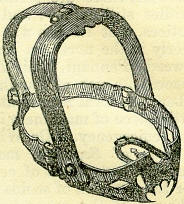 Tradition alleges that the instrument was given for the use of the parish by a neighbouring gentleman, of the name of Chester, who lost an estate through the indiscreet babbling of a mischievous woman to an uncle, from whom he had considerable expectations. This Walton bridle -which may still be seen in the vestry of the parish church-is a far less terrible-looking engine than Dr. Plot's. It is made of thin iron, and so contrived as to pass over and round the head, where the whole clasps together, and is fastened at the back of the neck by a small padlock. The bridle-bit, as it is called, is a flat piece of iron, about two inches long and one inch broad, which goes into the mouth, and keeps down the tongue by its pressure, while an aperture in front admits the nose. There are still numerous specimens of branks preserved in different private and public antiquarian collections throughout England. There was, until lately, a brank in the old Chester-field poor-house, Derbyshire; and there is still one at the Guildhall, Lichfield; one at Hamstall-Ridware, Staffordshire; one at Walsall, near Wolverhampton; and one at Holme, Lancashire. There was one in the town-hall at Leicester, now in private hands in that town. A brank which is recorded in 1623 as existing at Macclesfield, and is still seen in the town-hall, has been actually used, as stated by a writer in the Archaeological Journal of September 1856, within the memory of an aged official of the municipal authorities in that town. In Scotland, likewise, there are sundry specimens of gossips' bridles still extant; and it seems, from various notices, that its use was quite as frequent formerly in the northern kingdom as south of the Tweed. Pennant, in his Taur in Scotland, in 1772, records its use at Langholm, in Dumfriesshire, where the local magistrates had, it appears, their little piece of machinery in constant readiness for any emergency. Dr. Wilson, in his Prehistoric Annals of Scotland, mentions the brank as a Scottish instrument of ecclesiastical punishment, for the coercion of scolds and slanderous gossips. The use of the apparatus occurs in the Burgh Records of Glasgow as early as 1574, when two quarrelsome females were bound to keep the peace, or, on further offending, 'to be brankit.' In the records of the Kirk Session at Stirling, for 1600, 'the brankes' are mentioned as the punishment for a shrew. In St. Mary's church, at St. Andrew's, a memorable specimen still exists, known as the 'Bishop's brank,' sketched and noticed in the Abbotsford edition of The Monastery. Ducking-stools and branks, however, with all their terrors, seem to have been insufficient to frighten the shrews of former days out of their bad propensities. In addition to them the terrors of the Ecclesiastical Courts were held over their heads, as seen, among others, in the records of the diocese of London, which contain numerous entries of punishments awarded to scolds. The same in the provinces. In 1614, dame Margaret, wife of John Bache, of Chaddesley, was prosecuted at the sessions as a 'comon skould, and a sower of strife amongste her neyghbours, and hath bynn presented for a skoulde at the leete houlden for the manour of Chadsley, and for misbehavying her tonge towards her mother-in-law, at a visytacon at Bromsgrove, and was excommunicated therefore.' The excommunication appears to have had little effect in these and other cases; for only a few years after the date above recorded, the magistrates of the town of Kidderminster, not far from Chadsley, voted the purchase of 'a bridle for scolds.' Whether the 'bridle' was ever more popular than the stoole' is an open question; but, at any rate, both carried it, in the majority of instances, over the thunder of the Church. The thing called excommunication somehow never did thrive in England-not even for the taming of shrews. WILL OF A SMALL FARMER OF THE THIRTEENTH CENTURYFrom an inventory of the effects of Reginald Labbe, a small farmer, who died in 1293, we obtain a curious view of the circumstances of an individual of the agricultural class, at that early period. Reginald Labbe died worth chattels of the value of thirty-three shillings and eight pence, leaving no ready money. His goods comprised a cow and calf, two sheep and three lambs, three hens, a bushel and a half of wheat, a seam of barley, a seam and a half of fodder, a seam of 'dragge' or mixed grain, and one halfpenny worth of salt. His wardrobe consisted of a tabard, tunic, and hood; and his 'house-hold stuffe' seems to have been limited to a bolster, a rug, two sheets, a brass dish, and a tripod or trivet, the ordinary cooking apparatus of those times. Possessing no ready money, his bequests were made in kind. A sheep worth ten pence is left to the high altar of 'Neweton,' perhaps Newton-Valence, near Alton, Hants; and another of the same value to the altar and fabric fund of 'Eakewode,' possibly Oak-wood, near Dorking, Surrey. His widow Ida received a moiety of the testator's cow, which was valued at five shillings, and Thomas Fitz-Norreys was a co-partner in its calf, to the extent of a fourth. It is worthy of note, that the expenditure of the executors upon the funeral, the 'month's-mind,' and in proving the will of Reginald Labbe, consumed some-thing more than a third of all he left behind him, being in the proportion of 11s. 9d. to 33s. 8d. Some of the items are singular. One penny was paid for digging his grave, twopence for tolling the bell, six-pence for making his will, and eightpence for proving it, 'with the counsel of clerks;' in other words, under legal advice. We may safely multiply these sums by fifteen, perhaps by twenty, to arrive at the value of money in the thirteenth as compared with the nineteenth century; and by this process we shall find that the lawyer or clerk who prepared the will received a fee not greatly disproportioned to the modern charge for such professional assistance. The mourners bidden to the funeral, some of whom, probably, bore Reginald's body to its resting-place, were refreshed with bread and cheese and beer to the amount of six shillings: the same homely fare at the 'month's-mind' cost the estate two shillings and eightpence. The scribe who prepared this account for the executors was remunerated with threepence, a large sum having regard to the amount of labour. The document is in Latin, from which Mr. Hudson Turner prepared the preceding abstract. |